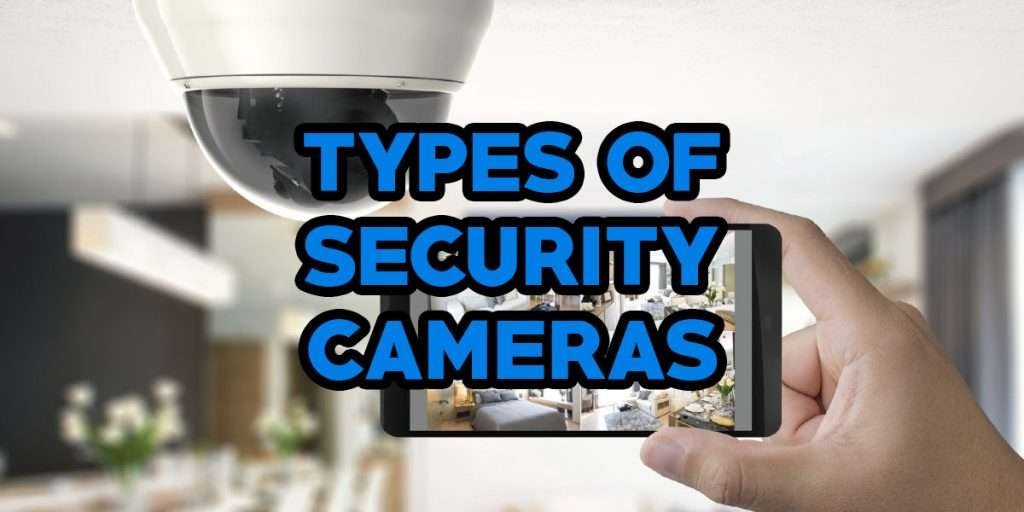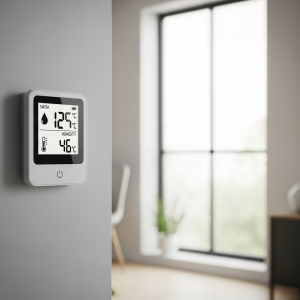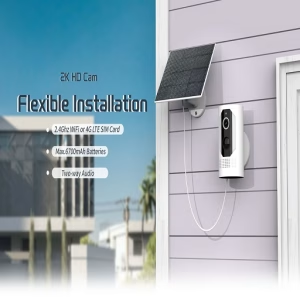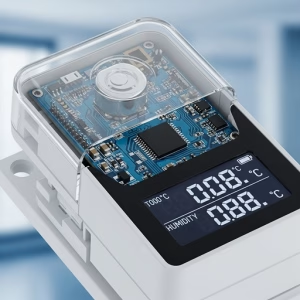In homes, businesses, and public places, security cameras have become an essential part of protecting property. Technology has made it possible to install a wide variety of surveillance cameras, each adapted to meet specific surveillance requirements. In addition to high-definition video, night vision, motion detection, and remote access, security cameras offer many features, from basic analog models to more sophisticated IP systems. Selecting the right security camera system that enhances security and provides peace of mind requires understanding the different types of security cameras and their unique capabilities.

Types of Home Security Cameras?
Wired Indoor Cameras
Many comprehensive surveillance systems use wired indoor security cameras, known for their reliability and consistency. Digital Video Recorders (DVRs) and Network Video Recorders (NVRs) connect these cameras to a central recording device through coax cables or Ethernet cables. It is also crucial to maintain the integrity of security monitoring when video footage is transmitted via a wired connection.
Usually, wired indoor cameras are dome-shaped and have a sleek appearance, making them less obtrusive when installed in a home. A dome camera mounted on the ceiling or wall can cover a wide area within the home, such as a living room, hallway, or entryway. With this wide-angle coverage, there are no blind spots within the surveillance area, allowing for comprehensive monitoring.
It generally requires professional expertise to install wired indoor cameras. Providing cables from the recording device to the walls or ceilings can be complicated and time-consuming. By placing cameras correctly and wiring neatly, professional installation avoids disconnections and interference with signals, ensuring maximum coverage and maximum coverage.
The reliability and high-quality video output of wired indoor cameras make them a popular choice. The higher resolutions and better night vision capabilities of these cameras make them less susceptible to interference than wireless cameras. In terms of quality of video and uninterrupted surveillance, wired indoor cameras are a good choice if you want your home security system to provide uninterrupted surveillance.
Wired Outdoor Cameras
In order for security systems to function effectively, it is vital to have wired outdoor cameras installed for reliable, high-quality surveillance of exterior areas. Video feeds can be stabilized by connecting these cameras to DVRs or NVRs via coaxial or Ethernet cables. Intruders are generally deterred by their long, cylindrical shape, which is typically designed as a bullet style.
Despite harsh weather conditions such as rain, wind, and dust, these cameras are weatherproof. Power over Ethernet, or PoE, permits cameras to receive power without needing to be plugged into an electrical outlet nearby (Power over Ethernet, or PoE). When used outdoors, where power outlets are limited, this configuration reduces wiring complexity.
It is important to choose wired cameras that are specifically rated for outdoor use to ensure durability, as many wired cameras can be used indoors and outdoors. An experienced technician will typically install the system, which requires running cables through walls or underground as well as securing the cameras properly.
Large properties and commercial properties that require consistent, high-quality surveillance are ideal for wired outdoor cameras because of their reliability, high-resolution video output, and resistance to interference. Owners can enjoy peace of mind knowing that they are covered comprehensively and have enhanced security.
Wireless Indoor Cameras
The ease of installation and diverse features of wireless indoor cameras make them popular for home and business security. Data transmission cables can be eliminated by connecting to a Wi-Fi network, but power and plugging them into an outlet are still required. The records from such cameras are stored in the cloud, which makes them accessible and manageable from any internet-enabled device.
There are a number of advanced features available with wireless indoor cameras that can be customized to meet specific needs. Owners can interact with their pets remotely by dispensing treats and using pet-specific models that allow two-way communication. Additionally, baby cams can play lullabies and provide two-way audio to ensure a baby’s comfort, as well as record temperature, humidity, and air quality.
The use of wireless indoor cameras enhances security and monitoring while being flexible and convenient. From general home security to monitoring pets and babies, they are excellent choices because of their ease of installation and cloud storage capabilities.
Wireless Outdoor Cameras
Similar to their indoor counterparts, wireless outdoor cameras are large and weather-resistant in order to withstand harsh environments. Data transmission is accomplished via Wi-Fi, eliminating the need for extensive wiring and opening up the possibility of flexible placement around a property. It is still necessary to plug them into an electrical outlet and provide them with power. With a robust construction, wireless outdoor cameras provide reliable surveillance in a variety of weather conditions, from rain and wind to extreme temperatures.
Wireless outdoor cameras are typically mounted using brackets and screws by attaching them to walls or structures. By installing the camera securely, it will remain in place and perform at its best despite outdoor conditions. Integrated spotlights and sirens are common features of wireless outdoor cameras. Additionally, these features serve to deter potential intruders, enhancing the overall security of the property by improving the camera’s ability to capture clear footage even in low light conditions.
The field of view of wireless outdoor cameras is typically 130 degrees or greater, which gives them an advantage over wired bullet cameras for covering a greater area. A comprehensive surveillance system such as this one ensures comprehensive coverage of extensive outdoor spaces like yards, driveways, and entrances. Wireless outdoor cameras are a great choice for enhancing outdoor security and providing peace of mind due to their easy installation, wide coverage, and advanced security features.
Wire-Free Outdoor Cameras
Usually rechargeable batteries, wire-free outdoor cameras offer a convenient and versatile alternative to traditional security cameras for outdoor use. Since they do not require an electrical outlet, they can be placed and installed more easily than traditional wireless cameras. Designed to fit confined or unsightly areas, these cables are ideal. It depends on the camera model and usage pattern how long the batteries in these cameras last.
As a result of these cameras’ motion detection capabilities, they record only relevant footage and conserve battery life. With motion-activated recordings, storage will be more efficient and fewer hours of unnecessary footage will need to be sorted through. It is possible to install wire-free cameras without any professional assistance in a few minutes. Those who prefer a hassle-free setup are likely to choose them because of their design.
In addition to high-definition video and night vision, wire-free outdoor cameras usually offer similar features to wireless cameras. The batteries, however, prevent continuous recording. The battery life of some cameras can be extended by installing a solar panel, which charges the batteries and extends their use. With this solar charging option, wire-free cameras become a reliable and efficient outdoor security solution that is more sustainable and requires less maintenance.
Floodlight Cameras
Cameras with floodlights combine the features of security cameras and floodlights, giving you a robust outdoor security solution. Motion detection is simultaneously detected by the camera and large, bright flood lights. With this dual functionality, the camera can capture clear video images even in low-light conditions. Potential intruders may also be deterred from approaching the property by the sudden activation of the floodlight.
Various floodlight camera installation options are available to accommodate different preferences and existing setups. Easily integrated into current electrical systems and ensuring continuous power, they are hardwired to existing lighting wires. In areas where hardwiring may not be practical, they can also be powered via an outlet, allowing flexibility in placement. A floodlight camera can be used anywhere, whether it be a home or a commercial venue, due to its adaptability.
Besides their primary purpose, floodlight cameras offer advanced features such as high-definition video, motion detection, two-way audio, and smart home integration. Real-time monitoring, communicating with visitors, and instant alerts on smartphones are some of the features that allow users to keep an eye on their properties. Bright lighting and sophisticated surveillance capabilities make floodlight cameras ideal for enhancing visibility, deterrence, and peace of mind for property owners.
Final Verdict
Different types of security cameras can be categorized based on a variety of factors. You need to understand the different types of security cameras before making a decision about whether you should install them in your home, business, or any other property. It is our hope that you can find this article useful. How do you protect your property with security cameras? Would you mind telling me how you like them? Share this article with family and friends and let us know what you think!




